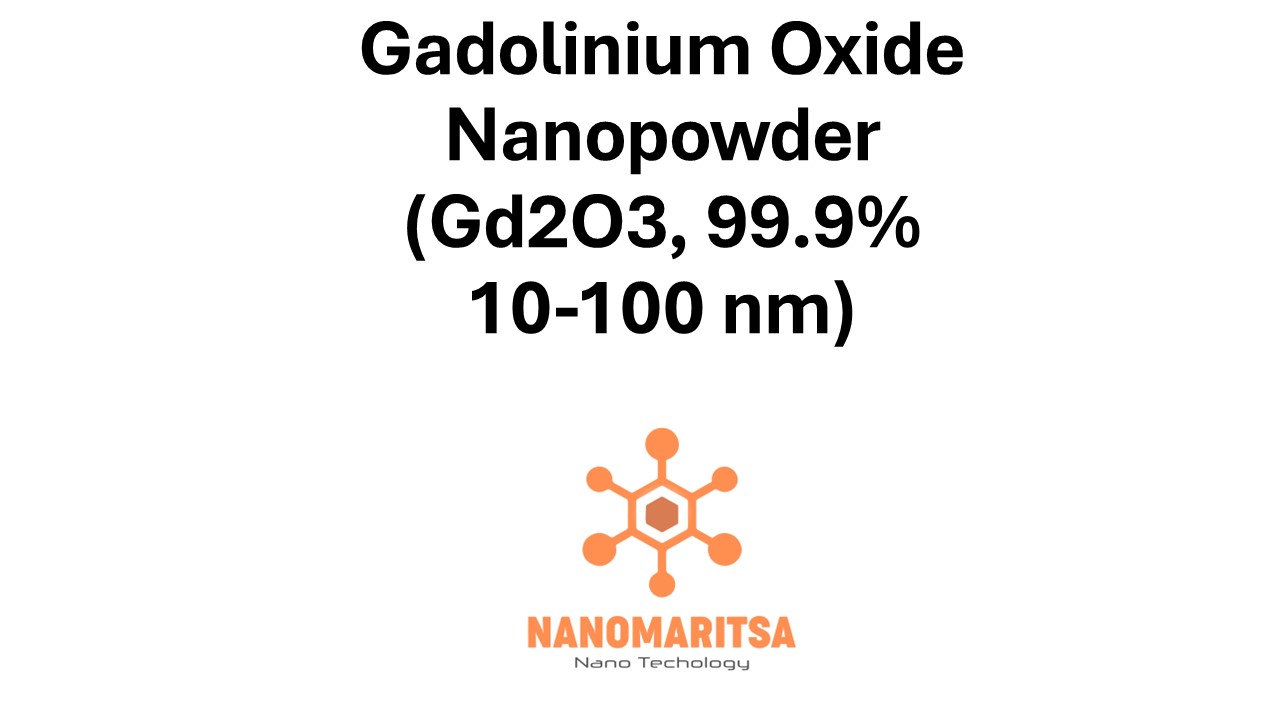Gadolinium Oxide Nanopowder (Gd2O3, 99.9%,10-100 nm)
€368.00
CompareGadolinium oxide nanopowder (Gd₂O₃, 99.9%, 10–100 nm) is a high-purity material with a wide range of applications due to its unique properties. It is commonly used in advanced technologies such as medical imaging, nuclear applications, and high-performance ceramics, owing to its excellent magnetic, optical, and chemical properties.
Composition and Structure
Gd₂O₃ (Gadolinium Oxide):
Gadolinium oxide is a compound of gadolinium, a rare-earth metal, and oxygen. It is a highly stable and non-toxic material that exhibits distinctive magnetic and luminescent properties.
Purity (99.9%):
The high purity of Gd₂O₃ ensures that the nanopowder is free from contaminants, which is important for applications that demand precise and reliable performance.
Particle Size (10–100 nm):
This range of particle sizes provides a balance between high surface area and material stability, making the nanopowder useful for various applications that require controlled properties such as magnetism, luminescence, and reactivity.
Properties
- Magnetic Properties:
Gadolinium oxide is paramagnetic, meaning it becomes magnetized in the presence of an external magnetic field. This property makes it particularly useful in medical imaging and magnetic applications. - High Surface Area:
The nanopowder’s small particle size offers a large surface area, enhancing its reactivity and making it suitable for use in catalytic and surface-sensitive applications. - Optical Properties:
Gadolinium oxide exhibits unique luminescent properties, which can be utilized in phosphorescent and fluorescent applications. - Chemical Stability:
Gd₂O₃ is chemically stable, especially in high-temperature and corrosive environments, making it a reliable material for various industrial processes.
Applications
1. Biomedical Applications:
Magnetic Resonance Imaging (MRI):
Gadolinium oxide nanoparticles are commonly used as contrast agents in MRI, improving the quality of medical imaging by enhancing the visibility of tissues and organs.
Cancer Therapy:
Due to their magnetic properties, Gd₂O₃ nanoparticles are also being researched for targeted cancer therapies, where they can be directed to specific areas in the body for localized treatment.
Drug Delivery Systems:
These nanoparticles are being explored for use in drug delivery, where they can help carry medications to targeted locations within the body, guided by an external magnetic field.
2. Nuclear Applications:
Neutron Capture:
Gadolinium is known for its excellent neutron-absorbing properties, making Gd₂O₃ valuable in nuclear reactors, radiation shielding, and other neutron-related applications.
Radiation Shielding:
Gadolinium oxide is used in the construction of radiation shielding materials due to its ability to absorb neutrons effectively, making it useful in nuclear power plants and medical radiation treatments.
3. Electronics and Optics:
Phosphors and Luminescence:
Gd₂O₃ nanoparticles are used as phosphors in display technology, including cathode ray tubes (CRTs) and in the production of fluorescent materials for lighting and screen displays.
Semiconductors:
Due to its unique electrical properties, Gadolinium oxide is also explored for use in semiconductors, especially in devices that require high temperature and radiation resistance.
4. Catalysis and Chemical Industry:
Catalysts:
Gadolinium oxide can be used as a catalyst in various chemical reactions, including those in the petroleum industry, helping to enhance the efficiency of refining processes.
Gas Sensors:
These nanoparticles are also used in gas sensors, where they detect gases like carbon monoxide, contributing to environmental monitoring and safety systems.
5. Ceramics and High-Performance Materials:
High-Temperature Ceramics:
Gd₂O₃ is used in the production of advanced ceramics, which are used in high-temperature and corrosive environments, such as in electronics and aerospace applications.
Superconducting Materials:
Research is ongoing into the use of Gd₂O₃ in superconducting materials, where it may play a role in enhancing performance by contributing to the formation of high-temperature superconductors.
Safety and Handling
Health Considerations:
While gadolinium oxide is generally considered non-toxic, nanoparticles can pose inhalation or skin contact risks due to their small size. Proper handling, including the use of protective equipment such as gloves and masks, is essential.
Environmental Impact:
The long-term environmental effects of gadolinium oxide nanoparticles are still being studied. However, it is generally considered to have low toxicity compared to other materials, and research continues to assess its environmental footprint.
Summary
Gadolinium oxide nanopowder (Gd₂O₃, 99.9%, 10–100 nm) is a highly versatile material with a wide range of applications in the fields of medicine, energy, electronics, and catalysis. Its unique magnetic, optical, and chemical properties make it valuable in advancing technologies such as MRI contrast agents, neutron absorption in nuclear reactors, and high-performance ceramics. As research into its properties and applications progresses, Gd₂O₃ nanoparticles are expected to play an increasingly important role in innovative solutions across multiple industries.
| Measurement (gr) | 100 grams, 500 grams, 1000 grams |
|---|
Related products
-
Single-Element Oxides Nanopowder
Cuprous Oxide Nanopowder (Cu2O, high purity, 99+%, 18nm)
0 out of 5(0)SKU: MN09NP0222€368.00 This product has multiple variants. The options may be chosen on the product page -
Single-Element Oxides Nanopowder
Erbium Oxide Nanopowder (Er2O3, 99.9%, 10-100nm)
0 out of 5(0)SKU: MN09NP0224€128.00 This product has multiple variants. The options may be chosen on the product page -
Single-Element Oxides Nanopowder
Aluminum Oxide Nanopowder (Al2O3, gamma, 99+%, 20nm)
0 out of 5(0)SKU: MN09NP0206€96.00 This product has multiple variants. The options may be chosen on the product page -
Single-Element Oxides Nanopowder
Aluminum Oxide Nanopowder (Al2O3, Alpha, 99.9%, 300nm)
0 out of 5(0)SKU: MN09NP0204€56.00 This product has multiple variants. The options may be chosen on the product page






